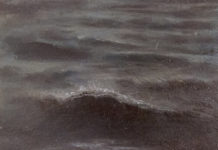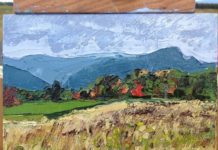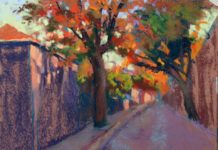
“One key aspect of my approach to plein air painting came out of my 13 summers as a smokejumper,” says Californian Davis Perkins, who came to our attention after he won an award in the PleinAir Salon competition. Find out what he means in this article, and during his presentation at the Plein Air Convention & Expo (www.pleinairconvention.com).

“Farley’s Barn,” by Davis Perkins, oil, 11 x 14 in. Private collection
“When you parachute in to fight forest fires, you have to be totally aware of all aspects of the terrain and the elements,” is one of the many understatements Davis Perkins offers as he describes his approach to outdoor painting. “In my landscape paintings, I try to combine this close observation of nature with the pure joy of discovery inherent in the process of painting directly from nature. I love the challenge of trying to capture the movement of fog and cloud, to paint the ever-changing atmosphere.”
Perkins has been a smokejumper, firefighter, paramedic, and professional artist. After serving as a paratroop sergeant, first with the Army’s 82nd Airborne Division and later with the 12th Special Forces Group of the Army Reserve, he worked 13 summers as a smokejumper, parachuting into forest fires with the U.S. Forest Service and Bureau of Land Management. During the winter he attended art school, and he graduated from the University of Oregon with a degree in fine arts. Now he is a dedicated plein air painter and sometimes volunteer firefighter and paramedic. As this e-newsletter is being distributed, Davis is back in Haiti for his fourth trip as a volunteer paramedic, helping a medical team set up clinics on the rural western side of the island.

“Mithow River Ranch (Washington),” by Davis Perkins, oil, 26 x 30 in.
“I drive to a location or hike with equipment in my backpack in which I pack my Open Box M pochade box,” Perkins explains. “When I find myself saying, ‘There it is!’ my viewfinder comes out and I begin thinking about a possible painting composition. I lay out my tools and paints and tone a RayMar Belgium linen panel with a thin wash of a warm earth color such as yellow ochre, and mix in a dark value. I quickly make a compositional sketch and pay particular attention to where the lightest lights are located.
“As I start to paint, I remind myself to stay loose, keep thinking and observing, and gauge the basic values from dark to light. In the early stages of painting, I don’t hesitate to wipe out some areas and add to others. When I’m happy with the composition, I lay out the full palette of my paints — titanium white, ivory black, yellow ochre light, burnt sienna, cadmium yellow light, cadmium red light, ultramarine blue, sap green, and cadmium green.”

“Fog Over Marin County,” by Davis Perkins, oil, 18 x 24 in.
Perkins continues, “I have my own technique for painting fog and clouds. Once the painting is started, I observe the fog, or the shapes of cloud formations, take a clean brush and Viva towels, and wipe out the cloud shapes or fog patterns by exposing the original panel surface. Once I have captured what I’m after, I build on the shapes using paint.
“Every studio painting has its beginnings in a plein air study. Working in nature is full of trials and tribulations, and it’s always a process of discovery. It’s important for me to be intuitive, spontaneous, and ready to paint what is truly inspiring while closely observing nature’s light and color. Sometimes I do take a few photographs for reference, in case I decide to do a larger painting in the studio.” For more information, visit www.davisperkins.com.




